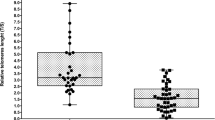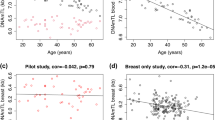Abstract
The etiology of endometriosis remains poorly understood but circulating stem cells may contribute. Telomeres shorten with cell divisions and age. Stem cells attempt to compensate for telomere attrition through the action of telomerase. Since circulating stem cells may contribute to endometriosis, we compared telomere content in lymphocytes of patients with and without endometriosis.
Methods
Observational study comparing peripheral lymphocytes telomere content, measured by quantitative polymerase chain reaction, in patients with (n = 86) and without endometriosis (n = 21).
Findings
Patients with endometriosis had longer telomeres than that of matched, endometriosis-free controls (telomere to single copy gene ratio [T/S ratio] of 1.62 vs 1.34, respectively, P = .00002). Patients with endometriosis were 8.1-fold more likely to have long telomeres. (odds ratio = 8.1, 95% confidence interval: 1.28-51.57, P = .0264).
Interpretation
Longer telomeres could be consistent with a stem cell origin of endometriosis.
Similar content being viewed by others
References
Metzger DA, Haney AF. Etiology of endometriosis. Obstet Gynecol Clin. 1989;16(1):1–14.
Eskenazi B, Warner ML. Epidemiology of endometriosis. Obstet Gynecol Clin North. 1997;24(2):235–258.
Lapp T. ACOG issues recommendations for the management of endometriosis. American College of Obstetricians and Gynecologists. Am Fam Physician. 2000;62(6):1431–1434.
Revised American Society for Reproductive Medicine classification of endometriosis: 1996. Fertil Steril. 1997;67(5):817–821.
Nisolle M, Donnez J. Peritoneal endometriosis, ovarian endometriosis, and adenomyotic nodules of the rectovaginal septum are three different entities. Fertil Steril. 1997;68(4):585–596.
Chapron C, Chopin N, Borghese B, et al. Deeply infiltrating endometriosis: pathogenetic implications of the anatomical distribution. Hum Reprod. 2006;21(7):1839–1845.
Sampson JA. Peritoneal endometriosis due to the menstrual dissemination of endometrial tissue into the peritoneal cavity. Am J Obstet Gynecol. 1927;14(14):422.
Harada T, Iwabe T, Terakawa N. Role of cytokines in endometriosis. Fertil Steril. 2001;76(1):1–10.
Halme J, Hammond MG, Hulka JF, Raj SG, Talbert LM. Retrograde menstruation in healthy women and in patients with endometriosis. Obstet Gynecol. 1984;64(2):151–154.
Vercellini P, De Giorgi O, Aimi G, Panazza S, Uglietti A, Crosignani PG. Menstrual characteristics in women with and without endometriosis. Obstet Gynecol. 1997;90(2):264–268.
Von Zglinicki T. Oxidative stress shortens telomeres. Trends Biochem Sci. 2002;27(7):339–344.
Wong JM, Collins K. Telomere maintenance and disease. Lancet. 2003;362(9388):983–988.
Chan SR, Blackburn EH. Telomeres and telomerases. Philos Trans R Soc Lond B Biol Sci. 2004;359(1441):109–121.
Tanaka M, Kyo S, Takakura M, et al. Expression of telomerase activity in human endometrium is localized to epithelial glandular cells and regulated in a menstrual phase-dependent manner correlated with cell proliferation. Am J Pathol. 1998;153(6):1985–1991.
Wright WE, Piatyszek MA, Rainey WE, Byrd W, Shay JW. Telomerase activity in human germline and embryonic tissues and cells. Dev Genet. 1996;18(2):173–179.
O’Callaghan NJ, Fenech M. A quantitative PCR method for measuring absolute telomere content. Biol Proced Online. 2011;13:3.
www.R-project.org. Accessed March 18, 2014.
Hapangama DK, Turner MA, Drury JA, et al. Endometriosis is associated with aberrante endometrial expression of telomerase and increased telomere length. Hum Reprod. 2008;23(7): 1511–1519.
Calado RT, Yewdell WT, Wilkerson KL, et al. Sex hormones, acting on the TERT gene, increase telomerase activity in human primary hematopoietic cells. Blood. 2009;114(11):2236–2243.
Bayne S, Liu JP. Hormones and growth factors regulate telomerase activity in ageing and cancer. Mol Cell Endocrinol. 2005; 240(1-2):11–22.
Sasson IE, Taylor HS. Stem cells and the pathogenesis of endometriosis. Ann N Y Acad Sci. 2008;1127:106–115.
Figueira PG, Abrao MS, Krikun G, Taylor HS. Stem cells in endometrium and their role in the pathogenesis of endometriosis. Ann N Y Acad Sci. 2011;1221:10–17.
Prescott J, Wentzensen IM, Savage SA, De Vivo I. Epidemiologic evidence for a role of telomere dysfunction in cancer etiology. Mutat Res. 2012;730(1–2):75–84.
Meresman GF, Vighi S, Buquet RA, Contreras-Ortiz O, Tesone M, Rumi LS. Apoptosis and expression of Bcl-2 and Bax in eutopic endometrium from women with endometriosis. Fertil Steril. 2000;74(4):760–766.
Harada T, Kaponis A, Iwabe T, et al. Apoptosis in human endometrium and endometriosis. Hum Reprod Update. 2004;10(1): 29–38.
Starzinski Powitz A, Handrow-Metzmacher H, Kotzian S. The putative role of cell adhesion molecules in endometriosis: can we learn from tumour metastasis? Mol Med Today. 1999;5(7): 304–309.
Brinton LA, Gridley G, Persson I, Baron J, Bergqvist A. Cancer risk after a hospital discharge diagnosis of endometriosis. Am J Obstet Gynecol. 1997;176(3):572–579.
Erzen M, Kovacic J. Relationship between endometriosis and ovarian cancer. Eur J Gynaecol Oncol. 1998;19(6): 553–555.
Jimbo H, Yoshikawa H, Onda T, Yasugi T, Sakamoto A, Taketani Y. Prevalence of ovarian endometriosis in epithelial ovarian cancer. Int J Gynaecol Obstet. 1997;59(3):245–250.
Abrao MS, Podgaec S, Dias JA Jr, et al. Deeply infiltrating endometriosis affecting the rectum and lymph nodes. Fertil Steril. 2006;86(3):543–547.
Kim CM, Oh YJ, Cho SH, et al. Increased telomerase activity and human telomerase reverse transcriptase mRNA expression in the endometrium of patients with endometriosis. Hum Reprod. 2007;22(3):843–849.
Author information
Authors and Affiliations
Corresponding author
Rights and permissions
About this article
Cite this article
Dracxler, R.C., Oh, C., Kalmbach, K. et al. Peripheral Blood Telomere Content Is Greater in Patients With Endometriosis Than in Controls. Reprod. Sci. 21, 1465–1471 (2014). https://doi.org/10.1177/1933719114527353
Published:
Issue Date:
DOI: https://doi.org/10.1177/1933719114527353




